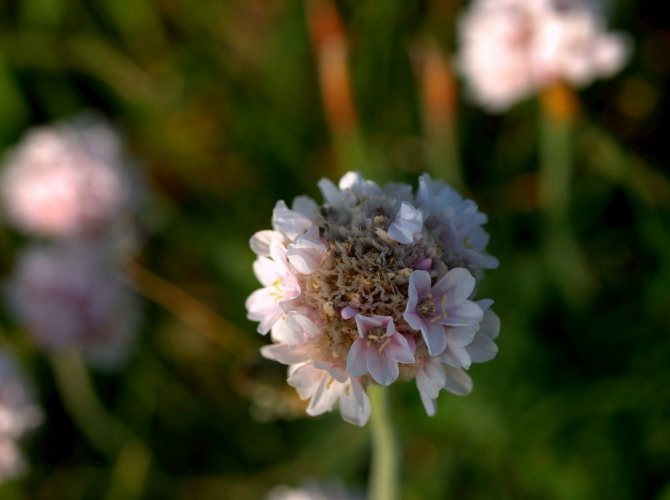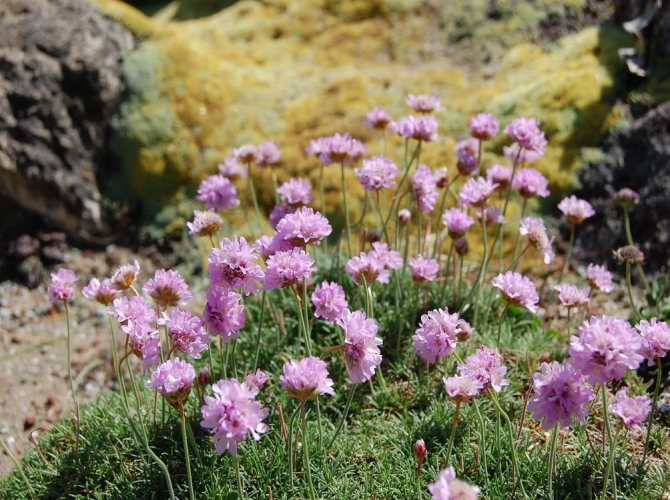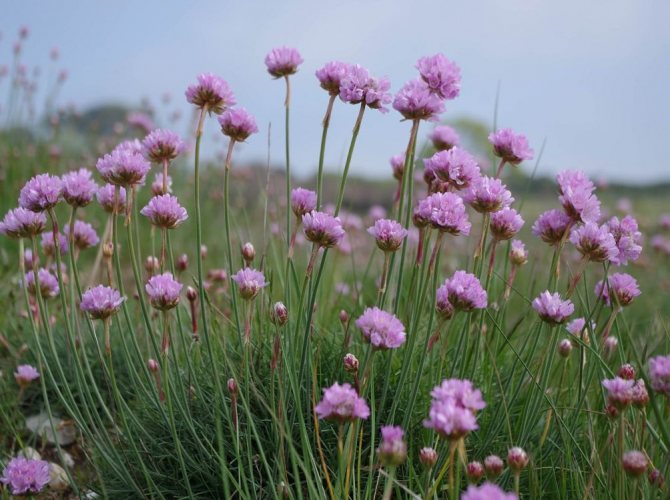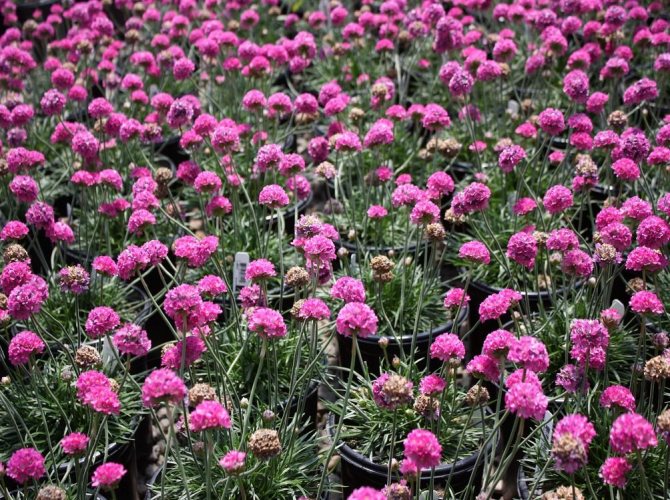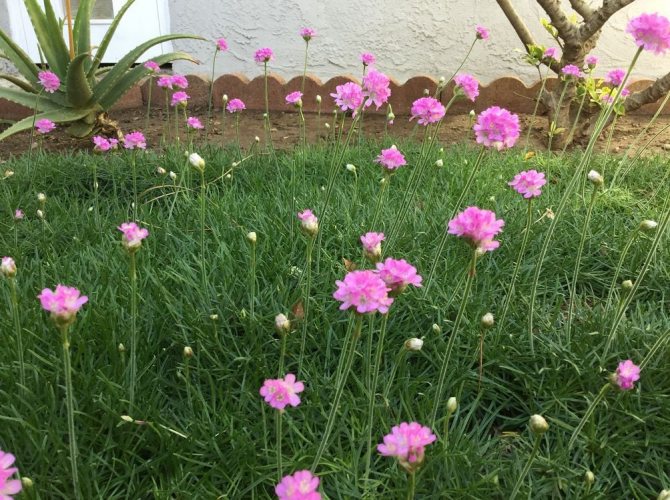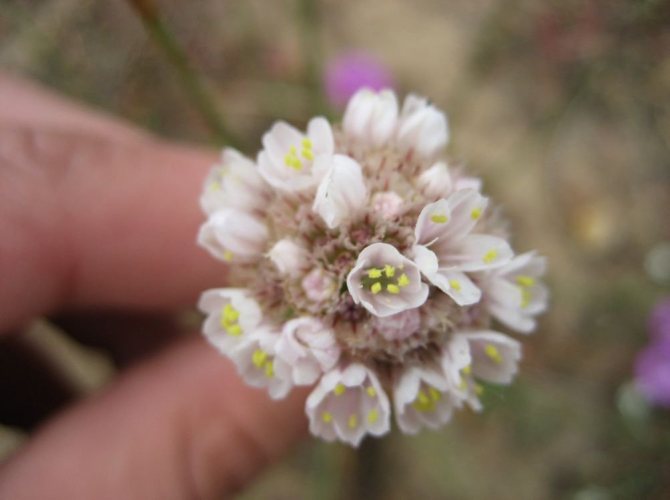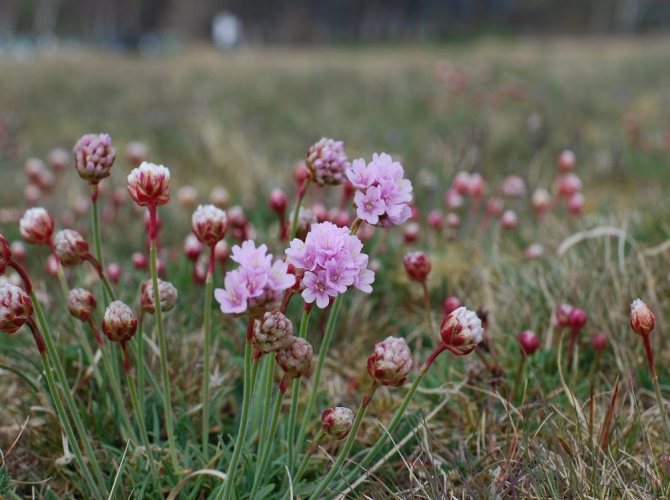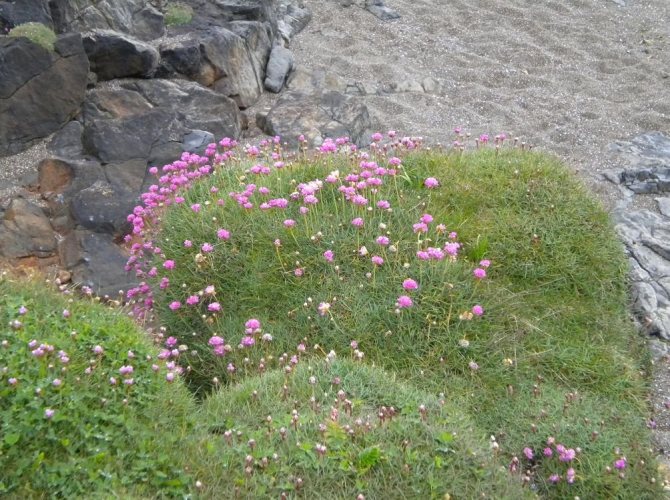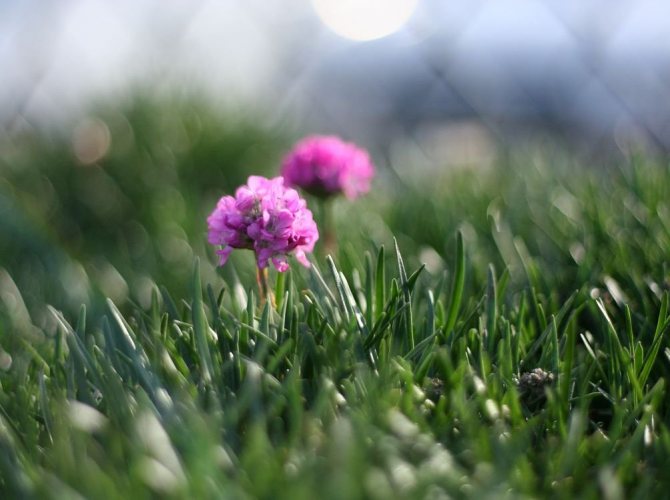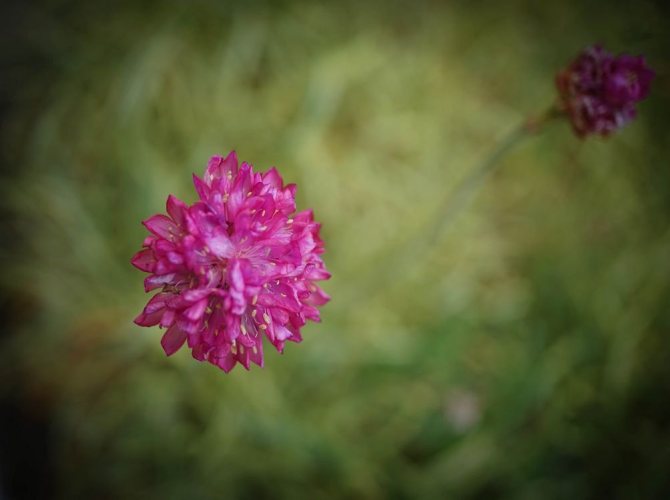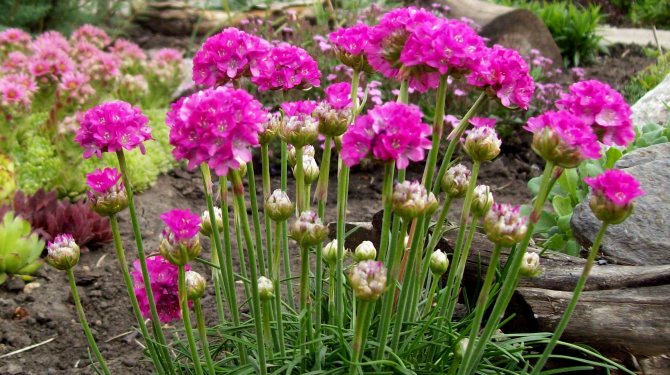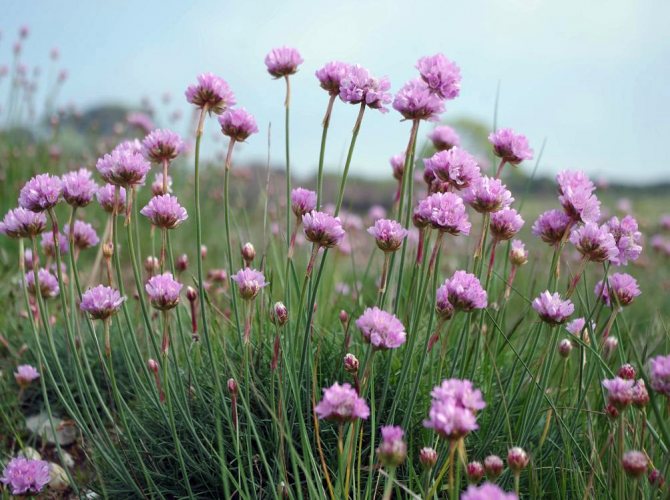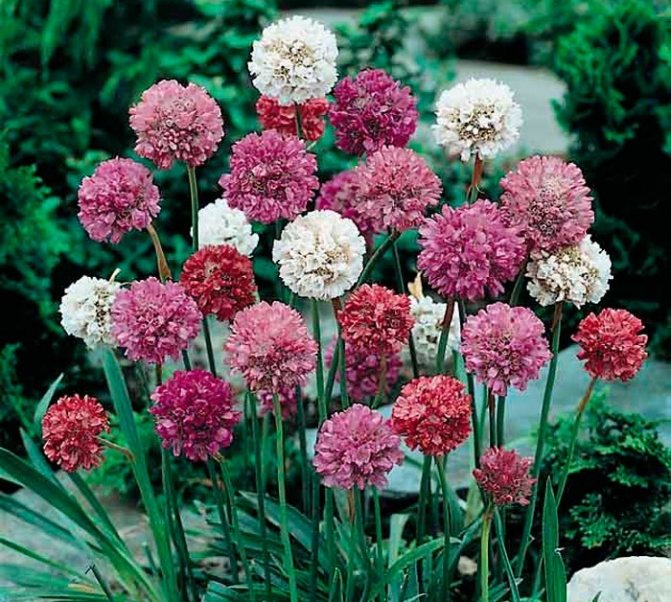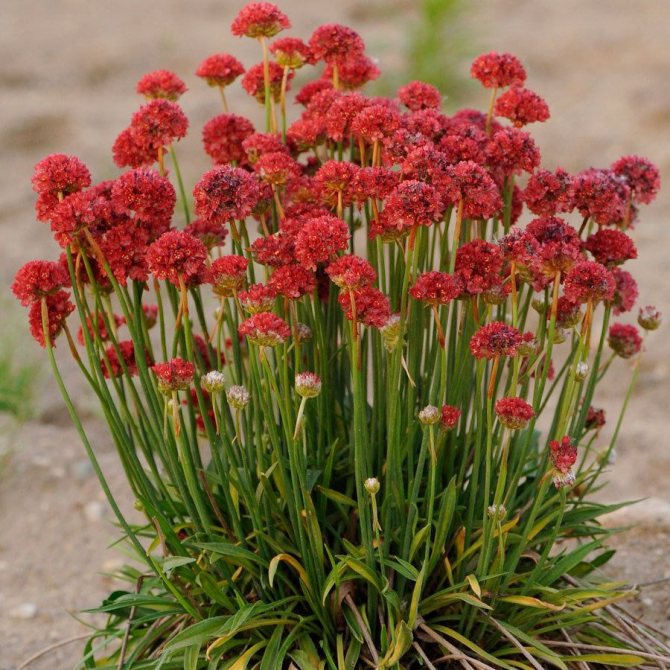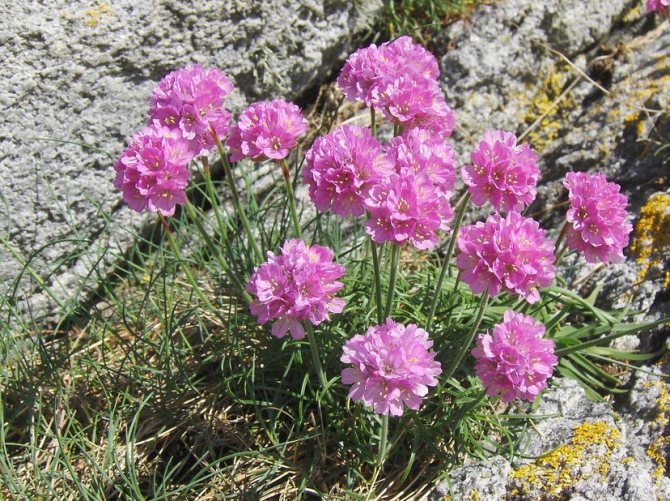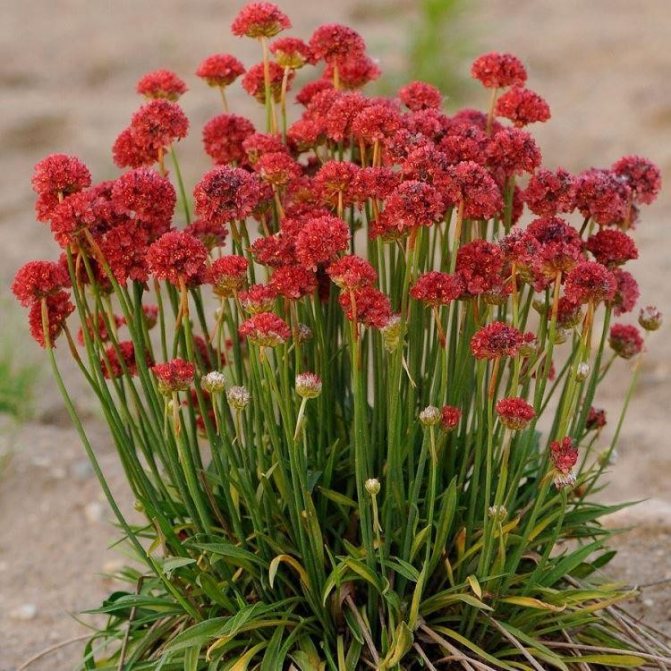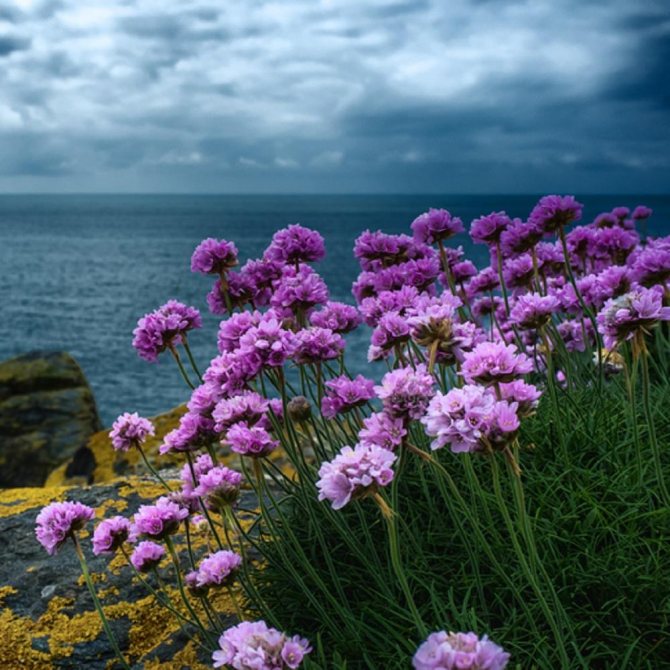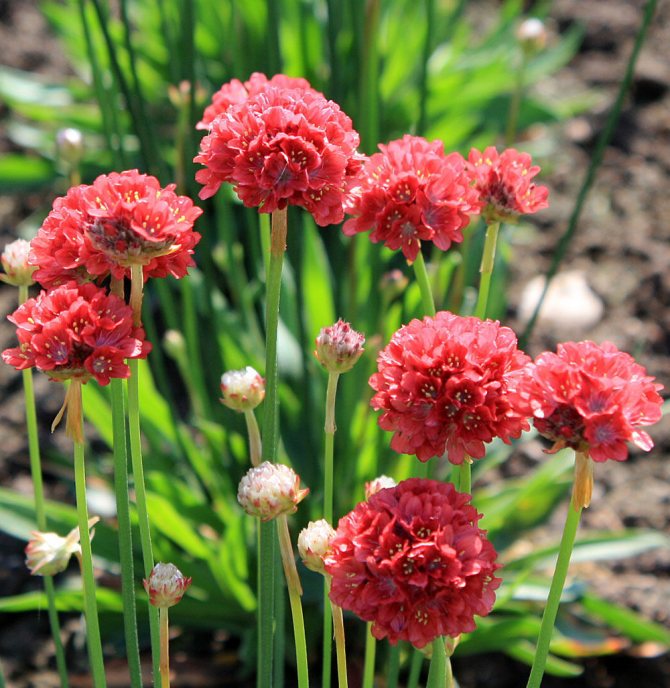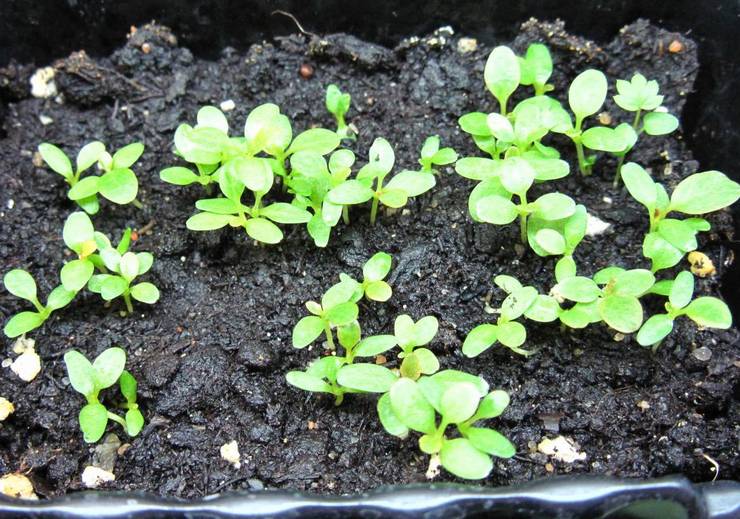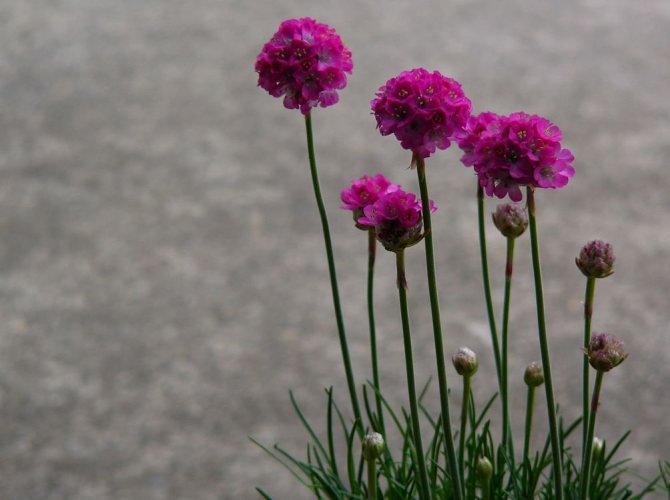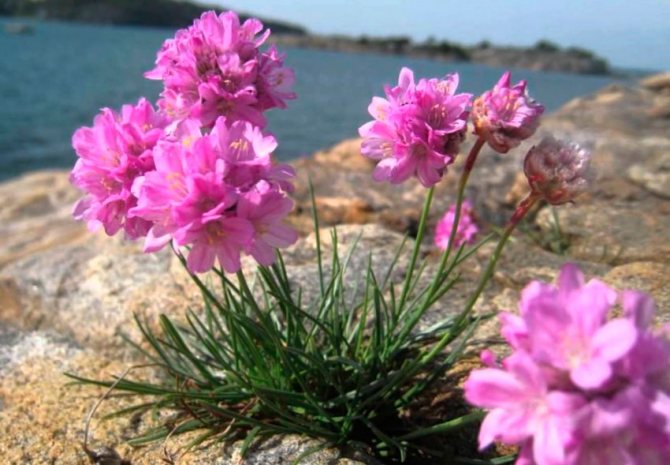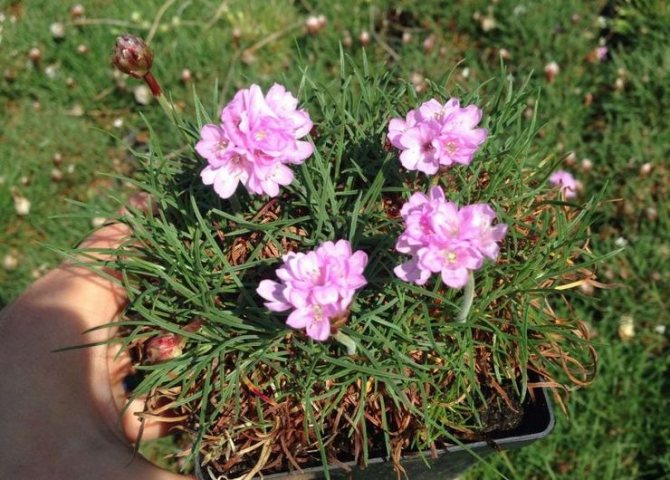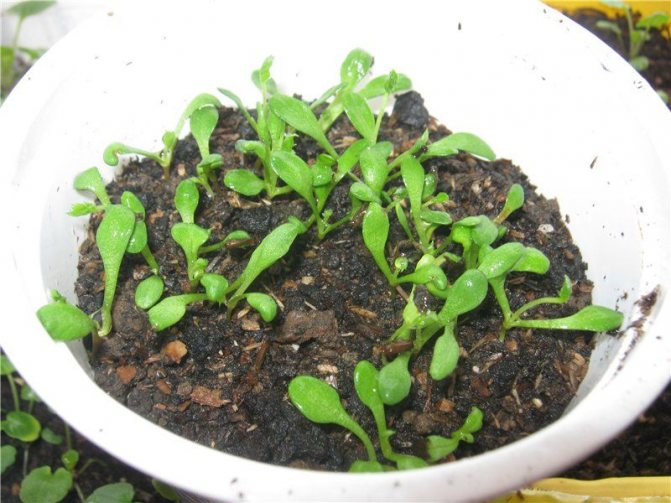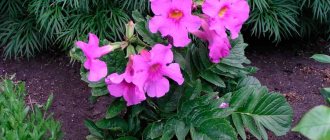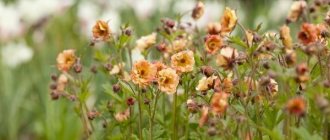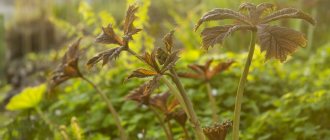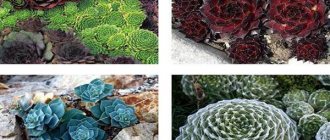Armeria is a perennial herb from the Pig family. It forms strikingly dense grassy sods, above which balls of dense, bright inflorescences rise on thin peduncles. In nature, the plant most often lives on mountain slopes near the sea, in the Mediterranean, North America, Mongolia and Eastern Europe. Thick green pillows can be used for landscaping a garden and decorating a flower garden. Even in temperate climates, Armeria feels great and tolerates wintering in the open field. Caring for her does not require much effort.
Botanical description
Armeria is a genus of perennial grasses. The sod height is about 15-20 cm, and during the flowering period it can reach 60 cm. The plant has a shortened taproot. A dense leaf rosette of narrow linear leaves is located above the soil surface. They are painted bright green or bluish and form a dense cushion, under which it is difficult to distinguish the ground.
Armeria begins to bloom in May and pleases gardeners with fragrant bright inflorescences until the end of summer. A long, erect stem grows from the center of the leaf rosette. Its smooth glabrous or slightly pubescent surface is dark green in color. Flowers on short stalks are located close to each other, so the inflorescence resembles a perfect ball. Bisexual buds are colored purple, pink, lilac or white. Corolla bracts grow together into a small tube, and 5 stamens are located in the center. After pollination, the fruits ripen - dry single-seeded capsules.
Flowering period and care after
During the flowering period, you need to take care that wilted inflorescences are removed in time, the soil remains moderately moist and loosened, you also need to feed the flower with mineral fertilizer. After it, it is required to remove all peduncles, continue to occasionally loosen and water the soil. No special action is required.
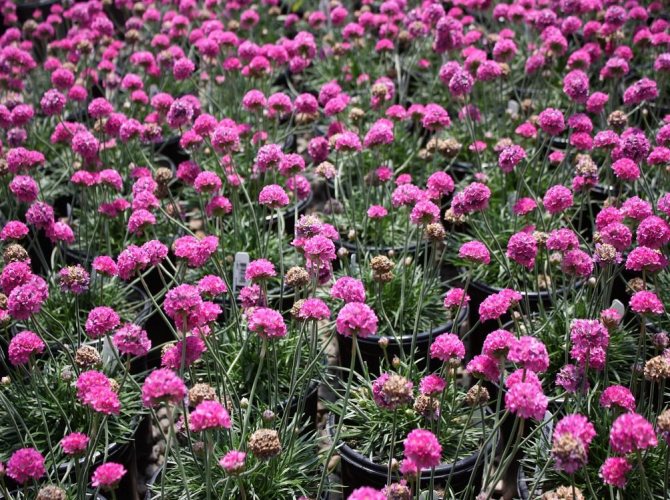
Armeria during flowering
Types of armeria
Botanists have registered about 90 species of armeria. The most popular is armeria seaside... It forms dense dark green sods. Plant height does not exceed 20 cm. Linear, slightly flattened foliage is colored blue-green. The capitate inflorescences, towering on pubescent peduncles, have a pink-purple hue. Flowering begins in late May and can be repeated in September. Popular varieties:
- Vindictive - blooms with large blood-red flowers;
- Louisiana - blooms with pink inflorescences;
- Alba - a variety with snow-white inflorescences;
- Solendens Perfecta - dissolves miniature light lilac flowers.
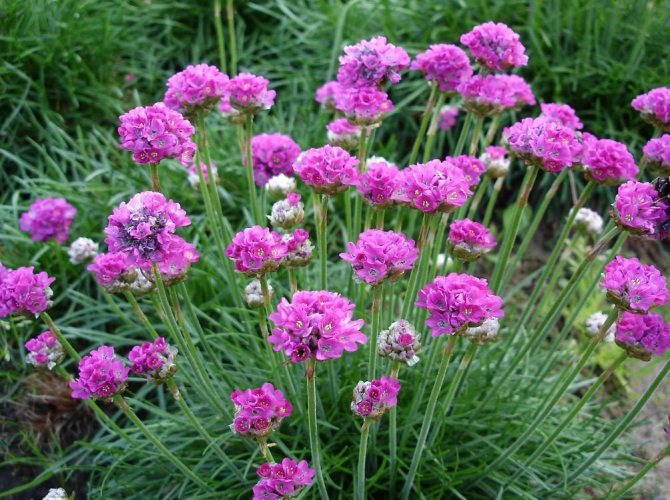

Armeria seaside
Armeria Alpine. The species lives on mountain slopes and is compact in size. The height of the sods does not exceed 10 cm, and the diameter reaches 30 cm. Many narrow bright green leaves persist even in frosty winters. In early June, a smooth peduncle 30 cm long grows from the center of the rosette. It bears a capitate inflorescence with a diameter of no more than 3 cm. Small bells in it are painted in light pink tones. Popular varieties:
- Rosea - the sod is covered with many bright pink inflorescences;
- Laucheana - blooms with carmine flowers;
- Alba - with snow-white buds.
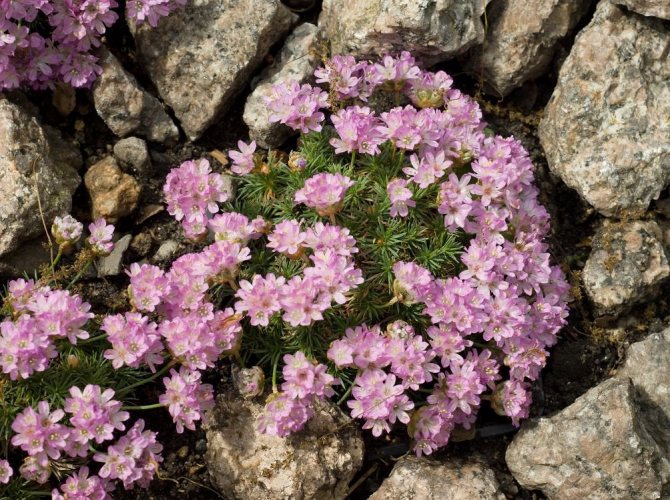

Armeria Alpine
Armeria is soddy. The plant is found in highland areas. It forms a dense curtain less than 15 cm in height. But the width of the bush can be 20 cm. The narrow dark green foliage is collected in dense rosettes. Inflorescences on short (about 6 cm) stems rise above it. This species blooms in July and pleases with flowers for up to 50 days. The flowering is so abundant that it is difficult to distinguish the leaves under the many inflorescences. The variety has the most capricious character. For normal development, she needs partial shade and shelter for the winter, since severe frosts can destroy this plant. Varieties:
- Bivenz Verayeti - white and pink double flowers;
- Brno - lilac double flowers.


Armeria turfy
Features and varieties
Armeria belongs to the genus of herbaceous flowering perennials of the Lead family. This genus unites about 90 species of different plants. According to one version, the name of this flower comes from two Celtic words such as: “ar” - “close, nearby” and “mor” - “sea”. So, to prove this version, a species was discovered that grows in the Armeria, while it loves to grow in the seaside dunes.


There is also a version that the name of the armeria stemmed from the word "armoires", this is how the bearded carnation was called in the old French language, and several varieties of armeria look like it. In natural conditions, such a plant can be found in the Mediterranean, America, Eastern Europe, Mongolia, and of course in Siberia.
Varieties and types
No wonder the Armeria is called a wild bearded carnation, there is a certain similarity. It is also called the sea flower, since it is the sea coast, even the rocky one, that serves this culture as a favorable environment for growth.


There are a great many varieties of it, about 90. But in Russia, certain well-known varieties are especially popular:
- Alpine... This perennial culture is very common in our country. Delicate pink flowers are combined in landscape design with almost any neighbors in the field of gardening. A low stem up to 15 centimeters in height with long peduncles up to 30 centimeters allows this species to be used as decorative borders. There are varieties with white (Alba), carmine pink (Rosea) and carmine red (Laucheana) flowers.
- Armeria is beautiful... The variety is considered evergreen, the leaves overwinter easily under the snow. The plant grows to a height of 40 centimeters with rosettes of leaves and inflorescences of snow-white (Joystick White), bright pink (Bees Ruby) and even burgundy flowers (red planet). Blooms from early to late summer. Other names for this variety are Louisiana, pseudo-army.
- Armeria seaside... This type is one of the most popular, perfect for rocky gardens and artificial surroundings of reservoirs and waterfalls. It grows along the sea coasts. Differs in high drought resistance. Varieties with white (Alba, Cotton Tail), pink (Rosea Compacta), scarlet (Vindictive), dark red (Düsseldorfer Stolz, Bloodstone) flowers have been bred.
- Armeria turfy... Probably the only variety of armeria that cannot withstand the winter, even the warm one, without help, the bushes should be covered for the cold period. But in summer, the plant can bloom so generously that even the foliage is not visible. Popular varieties with double lilac (Brno) and pale pink (Bevan's Variety) flowers.
Seed collection
In the event that armeria is grown on your garden plot, then there is no particular need to collect its seeds, since it reproduces excellently through self-seeding. And you should not forget that the bushes will need to be planted regularly, while dividing them into divisions, and the sowing plants will multiply with their seeds, so you will probably have enough planting material. In the same case, if you want to share the armeria with someone, then it is better to give some of the cut or cut a few cuttings.
However, if you really need seeds, then the inflorescence, which will begin to wilt, will need to be tied with a piece of gauze, which will prevent the seeds from falling to the surface of the soil. A completely dried inflorescence should be carefully trimmed. The seeds need to be shaken out on a leaf. After that, they are cleaned of plant residues. When the seeds are dry, they should be poured into a paper bag.
In landscape design
The culture is almost ideal for alpine slides and rock gardens. Wherever there are gaps in the stone on the territory, armeria can be planted, and the combination of the grayness and coldness of the stone with bright velvet flowers will always be successful.
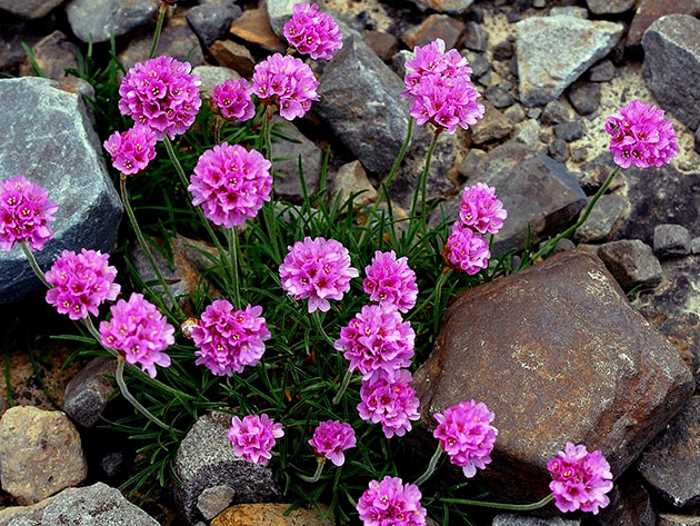

Armeria can often surround artificial reservoirs, areas for serene relaxation, border the beds of other crops. In flower gardens, the plant successfully coexists with creeping phlox and Carpathian bell. Armeria inflorescences on high peduncles, cut before blooming and dried, are used to create winter bouquets of dried flowers.
Growing from seeds
Armeria from seeds can be grown through seedlings or sown directly into the ground. The latter is possible only in the southern regions, since the seeds sprout with the first warm days, but may suffer from recurrent frosts in the future. Sowing in open ground is carried out in November, so the seeds will undergo natural stratification and sprouting will appear in March.
Growing seedlings begins in mid-February. Beforehand, seeds must be stratified within a week at a temperature of + 2 ... + 8 ° C. Then they are soaked in warm water for a day and sown in a container with a sand-peat mixture to a depth of 5 mm. Germinate at a temperature of + 16 ... + 20 ° C. Seedlings appear within 2-3 weeks. In greenhouses, seedlings continue to grow until mid-May, when the plants are strong enough and the probability of frost will disappear.
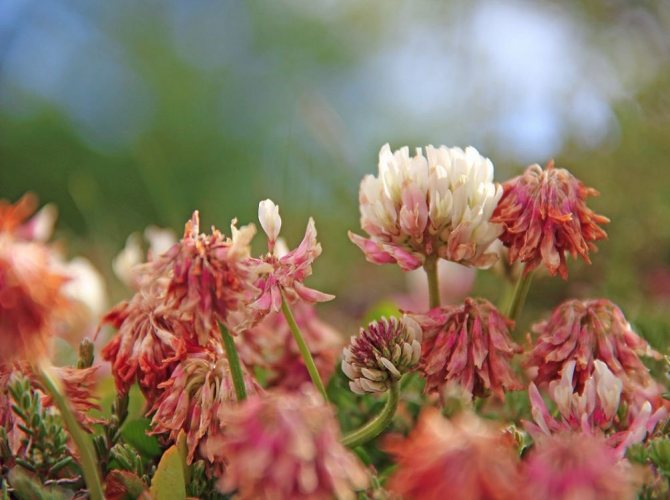

Climate
In warm climatic zones, the plant calmly transfers the planting directly into the ground and rises calmly. But even in temperate climates, it takes root well - it tolerates rainy weather and drought. The plant can withstand severe winter frosts, only for this period it needs to be covered.
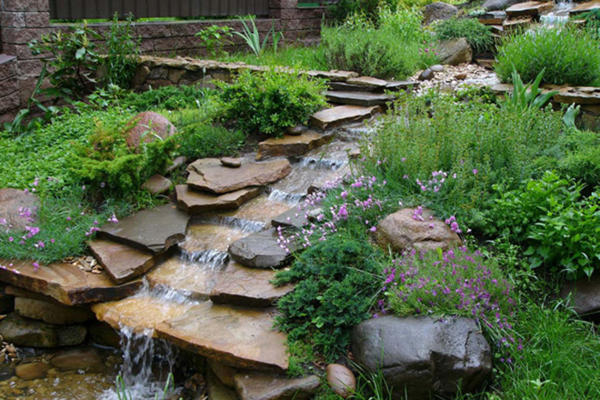

Armeria looks harmonious and grows well near natural and artificial reservoirs
Based on the natural living conditions, the flower grows especially well in summer cottages that are located near ponds, or where artificial waterfalls and small ponds are equipped. This culture looks fantastically beautiful next to water.
Vegetative propagation
Shrubs form many basal processes every year. The dense turf can be divided into several parts and planted in different parts of the garden. The first division is made at the age of 3 years. The procedure is carried out at the end of summer, at the end of flowering. The bush is completely dug up and divided into several parts. All cuttings should consist of plants with a strong root system. The distance between new landings should be at least 20 cm.
Throughout the summer, you can propagate armeria by cuttings. This implies the separation from the turf of a young rosette without roots, or with an underdeveloped rhizome. Rooting is carried out in the open field. Having planted the cutting in loose, well-drained soil, it is covered with a cap for 1-2 weeks, but aired and watered daily as needed. Rooting takes place pretty quickly.
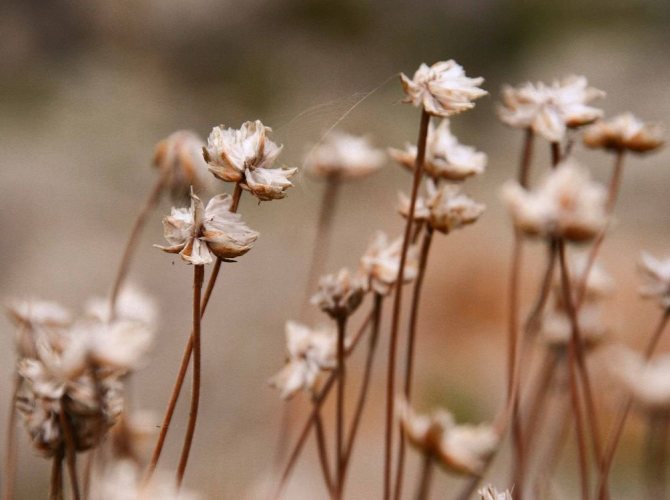

Watering and loosening the soil
Despite the fact that planting and caring for an army in the open field will not cause difficulties, a minimum of recommendations should be followed. The flower is able to survive periods of drought, but it is still recommended to water it from time to time.
Saxifrage flower - planting and home care
During the particularly dry season, it will be useful to spray the leaves and flowers with a spray bottle or a special garden spray.The bush will grow and develop if the soil around it is loosened occasionally.
Important! Do not overmoisten the flowers, as they do not tolerate stagnant water.
Landing in open ground
Armeria is a light-loving plant, therefore, open, well-lit areas of the garden are selected for planting. It is recommended to immediately take care of protection from drafts and strong gusts of wind. The soil for armeria should have a neutral or slightly acidic reaction. The presence of lime in the soil is undesirable. To prepare an alkaline soil, ammonium nitrate and acetic acid are added to it. Sandy loam stony soils are most suitable for growing armeria. If there are none on the site, a layer about 20 cm thick can be created independently from a mixture of river sand, turf and greenhouse land.
A few days before planting, the soil is loosened well and a complex of organic fertilizers (crushed sawdust, hay, needles and humus) is applied. To obtain separate armeria sods, the distance between the seedlings should be about 40 cm. To form a continuous carpet, it is cut in half. Planting holes are made shallow so that the root collar is located above the soil surface. The soil is compacted and watered moderately. You can scatter pebbles on the surface or make masonry.


Armeria: planting and breeding
Seed propagation of armeria occurs both by seedling and non-seedling methods. In open ground, seeds of armeria are sown at the end of autumn (so that they undergo natural stratification over the winter) or in spring, at the beginning of March. For ready-made seedlings in greenhouses, seeds of armeria are sown at the end of February or the beginning of March. In addition, Armeria reproduces well by self-seeding. Wherever you sow seeds of armeria - directly into the ground or into a container for seedlings - they are sealed shallowly, sprinkling on top with a layer of earth of half a centimeter. The germination rates of Armeria seeds are high.
Seedling
Sow seeds into the prepared soil, poured into shallow containers, to a depth of 2 centimeters.
Place containers in a warm, light place and wait for shoots. After the seedlings rise and they have two real leaves, they must be cut into separate pots or into a greenhouse and grown.


Sowing seeds directly into the ground is allowed in the spring, but it does not give good germination even from prepared and treated seeds.
The grown, matured seedlings can be planted in the personal plot as soon as the threat of spring frosts has passed. First you need to decide on the choice of a place in the garden where your perennial will rise. It should be with soil full of sand and stones. Warm and not shaded. An alpine slide or a flower bed near a reservoir is perfect.
For reference: Armeria flowers cannot stand alkaline earth. Planted in such a land, they get sick and lose their decorative effect. If your garden has calcareous soil, you need to neutralize the lime by sprinkling with a vinegar solution. Or by adding ammonium nitrate to the soil, when preparing an earthen plot for planting.
Add organic matter to the soil a few days before planting. If you, as a landscape designer, have decided that the armeria will grow in a group and cover the ground with a carpet, you need to plant the plants in a checkered order with a step of 15–20 centimeters. To do this, you can divide the planting site with lines, and plant seedlings at their intersection. If the plants are to be shaded, they are planted one at a time at a distance of up to 40 centimeters.
When planting an armeria, the root collar must not be buried. Near the seedlings, it is necessary to compact the earth and water them. For the next three weeks, remember to water the "beginners", not allowing the soil to dry out completely.
Sowing in the ground
Residents of areas with severe winters can afford to do without seedlings by planting seeds directly in open ground in the fall. Seeds are similarly stratified in natural conditions.
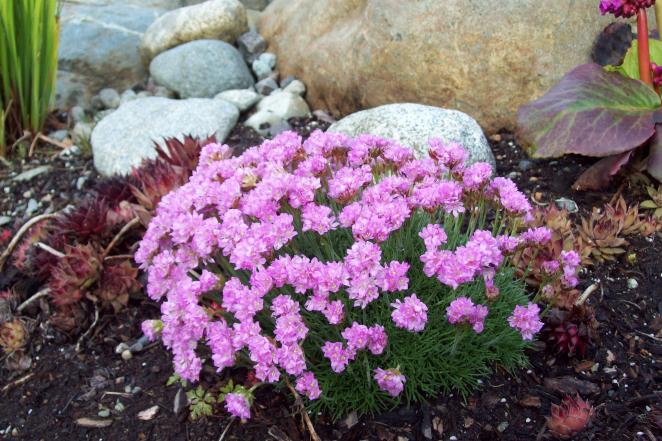

The principles of planting in the ground are the same as in the seedling method. However, in the spring it is necessary to carefully carry out the first weeding, so as not to pull out the armeria, the sprouts of which are easily confused with weeds.
Dividing the bush
Divide the bushes of a plant that is 3 years old. The procedure is carried out immediately after winter or with the arrival of autumn at the end of the flowering stage. The dug out bushes are divided into shares, the sections are treated with activated carbon. Landing in the open field is done in 15 or 20 centimeters increments. The harsh beauty of the rock plants conquers. Armeria in your garden will certainly take its deserved place.
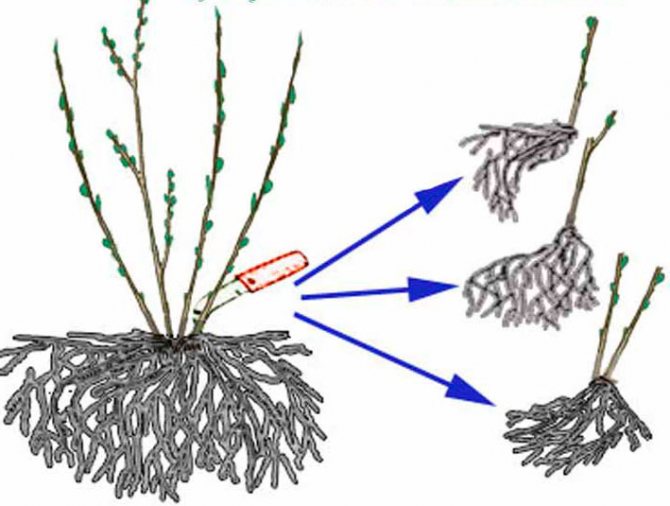

She can revive stone slides, decorate a rabatka, path or alley. It is often used in combination with creeping plants. If you prefer mountain landscapes or sea cliffs, then this romantic flower is for you. The variegation and severity of inflorescences, luscious green leaves - all this can give a refined charm to your decorative park.
Cuttings
When propagating armeria by cuttings, it is necessary to select and cut small rosettes from the plants. They need to be planted in the ground. To do this, dig a shallow hole, attach a stalk, sprinkle with earth, slightly compact the earth and water.
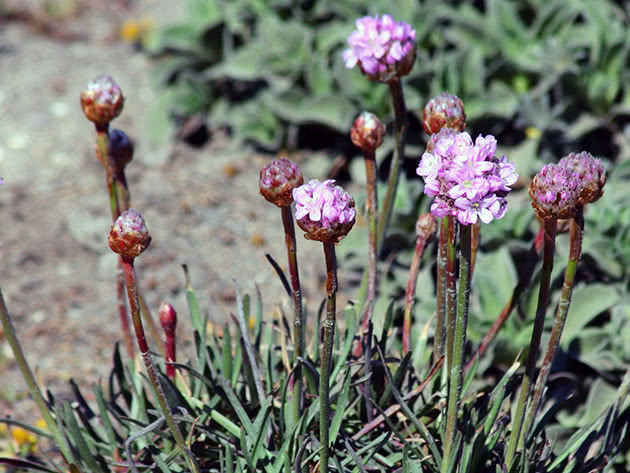

Cuttings should not be planted too deeply or they will not germinate. The gap between the bushes should be about 25 - 30 centimeters. Cuttings can be planted throughout the summer season.
Plant care
If the place for the armeria is chosen correctly and the planting conditions are met, it will be easy to take care of the armeria in the garden. She needs moderate watering. In rainy weather, there will be enough natural precipitation, but in summer heat and drought, it is recommended to irrigate the bushes by sprinkling. The soil should dry out between waterings.
Every 1-1.5 months, Armeria is fertilized with mineral fertilizers for flowering plants. The fertilizer solution is poured into the soil instead of watering. Thanks to this, the leaves will be especially bright, and the flowering will be abundant. On peat and loamy soils, the need for fertilizing is not so great, because the plants get everything they need from the nutrient soil.


After the end of flowering, it is worth immediately cutting off the wilting inflorescences. This can not only increase the attractiveness of the green cover in the garden, but also achieve the reappearance of flowers in the armeria in August or early September.
Armeria overwinters in central Russia and more southern regions under the snow, without additional shelter. For turfy armeria, cover with spruce branches or non-woven material is provided. They will also protect other species in severe frosts. It is advisable to prevent the accumulation of moisture near the plants, since during the dormant period the armeria does not tolerate waterlogging of the soil.
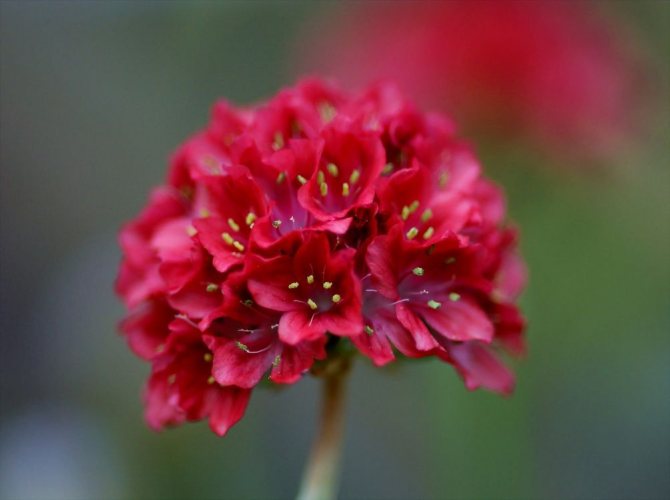

Flowers very often suffer from parasites and plant diseases. With regular flooding of the soil, the development of root rot or leaf spot is possible. This problem is especially relevant in early spring, when the snow is melting. Affected specimens slow down in growth and do not bloom. If the disease is detected at an early stage, fungicide treatment will help heal the affected plants.
The most common and dangerous pest for armeria is aphid. It literally dries up the foliage. At the beginning of summer, it is recommended to carry out preventive insecticide treatment. If parasites are found, it is repeated according to the instructions. The most effective drugs are Intavir, Karbofos, Kinmix and others.
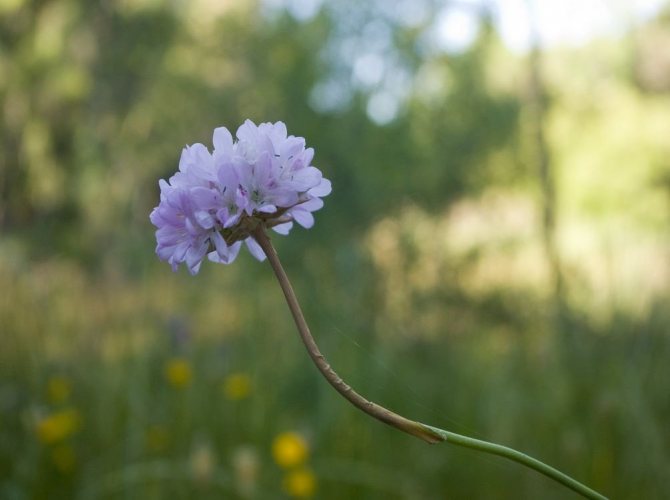

Diseases and pests
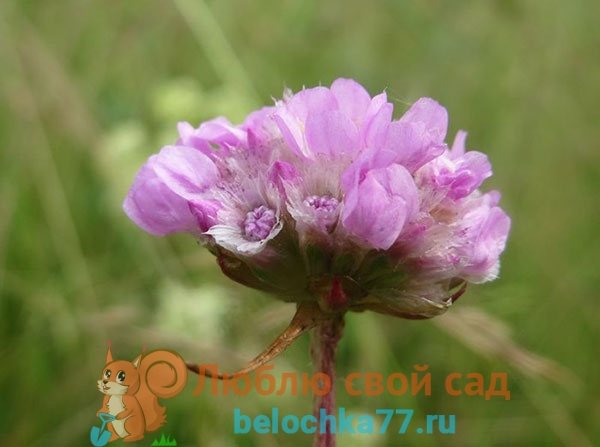

Diseases and pests rarely annoy Armeria. It can hurt during dormancy, especially insufficiently acidic soils weaken the plant.Aphids can attack the armeria, and spotting is also possible. A measure of disease prevention is the cardinal pruning of armeria. In case of pest infestation, industrial insecticides can be used.
Sometimes root decay can occur, this happens from excess moisture in the soil. If root rot is suspected, the bush is dug up, examined, all damaged areas are removed and planted in a well-drained place. Water the armeria more moderately later on.
Armeria in the garden
Armeria is beautiful for its dense, vibrant vegetation. It is used in mixborders, ridges, rocky gardens and rock gardens. Plants on stony masonry or natural mountain slopes also look good. The dense foliage maintains its beauty all year round, forming a solid green carpet. In summer, a pattern of bright, fragrant inflorescences of an unusual shape blooms on it.
In the flower garden, Armeria goes well with undersized flora (phlox, thyme, saxifrage, bells). You can also create a composition exclusively from armeria of various types and varieties. Inflorescences are well preserved after drying, so they are used in dry compositions. To do this, they are cut at the peak of flowering and dried by hanging them down with their heads.
When and how to collect?
It makes no sense to collect seeds if the armeria, planting and caring for which are discussed in detail in this article, is already growing on the site - it reproduces well by self-sowing. An indispensable element of care is the seating of the divisions and the division of the rhizome, so you will always have an excess of planting material, while sowing the seed itself. If you plan to share your armeria with someone, you can cut the cuttings or give a few divs when transplanting. If you need to have seeds, then tie the wilting inflorescence with gauze so that the ripe seeds do not fall to the ground, and after the inflorescence is completely dry, remove it, shake the seeds onto a newspaper, clean them and, after drying them, pour them into a bag from paper.
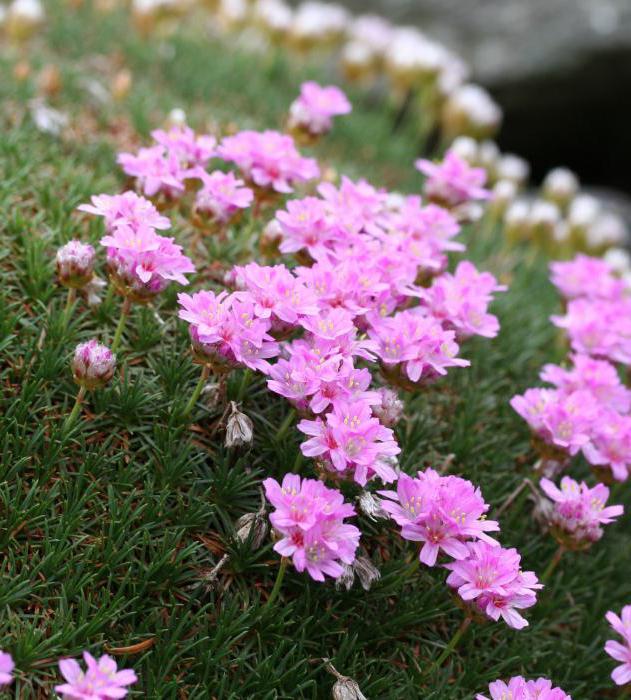

7.Use in landscaping
When grown in a garden, Armeria can be used as a curb or groundcover. The flower can decorate the rocky slopes of alpine hills and form a beautiful edging in a flower bed or flower garden.
When grown as a ground cover plant, Armeria bushes are arranged quite tightly when planting, and in this case it forms a continuous grassy rug.
The combination of Armeria with such low perennial plants as saxifrage, Arabis, Aubrieta, Kotula will look great. You can also plant nearby daisies, street sedum and thyme varieties, and subulate phlox.
Armeria belongs to evergreens and from under the snow appears once with green leaves, and therefore it is able to decorate the garden area during all warm months - from melting snow cover to snowfall.
↑ Up,







